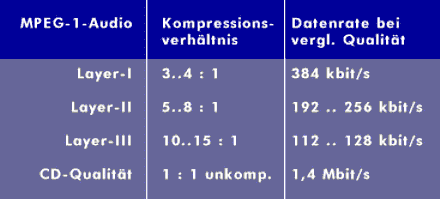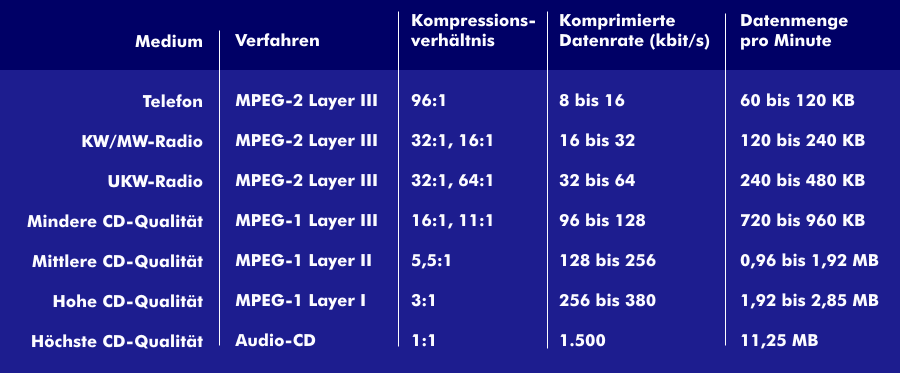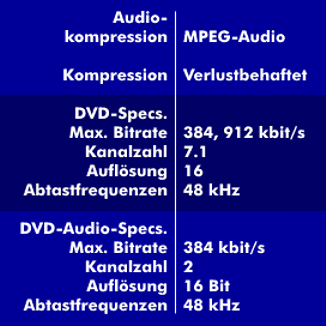MPEG-1 audio
MPEG-1 audio has evolved from classic MPEG-1 and is used to compress audio files. In this lossy compression, inaudible sounds are filtered out and not processed.
The different layers of MPEG-1 audio
MPEG-1 audio distinguishes between different layers that represent different filtering methods, transformation techniques and, as a result, different compression factors and quality standards. Thus, some compression techniques are better suited for audio compression of high quality hi-fi audio, others for radio quality, and still others for voice transmissions. The method works with sampling rates of 32 kHz, 44.1 kHz and 48 kHz. The 44.1 kHz sampling rate is used for audio CDs. In studio quality with a sampling rate of 48 kHz and a quantization of 16 bits, the resulting data rate is 768 kbit/s for mono and 1.536 Mbit/s for stereo, resulting in a data volume of 11.52 KB/min. For low quality audio, data rates can range from 32 kbit/s to 192 kbit/s for a monophonic signal.
Correspondingly, the ranges in compression ratios go from about 4:1 for MPEG-1 (audio) Layer-I to 12:1 for MPEG-1 (audio) Layer-3 and even 88:1 for voice transmissions using MPEG-2 on Layer-3.
Layer 1 of MPEG-1
During compression in MPEG-1 Layer-I (MP1), the frequency components of the audio signal to be compressed are filtered out using subband coding in 32 bandpass filters with identical bandwidths of 625 Hz. For data reduction, the individual frequency bands are masked according to human hearing behavior before being individually quantized. The encoding is done with 384 samples per channel, which form one frame. On MP1, the two audio channels can be processed separately or partially together for further data reduction.
MPEG-1 (Audio) Layer-II (MP2) has a higher complexity compared to MP1 and uses three subframes for coding, each with 384 samples per frequency band; i.e. a total of 1,152 samples per band. This results in more efficient masking of the bands. The resulting data rate for MP2 is about 200 kbit/s, lower than that of MP1 at 380 kbit/s. MP2 is used in the Musicam process for streaming transmissions in digital broadcasting such as Digital Audio Broadcast( DAB).
Layer 3 of MPEG-1
MPEG-1 (Audio) Layer-III( MP3) is the best known compression method of MPEG audio. It works with a much higher number of frequency bands, allowing it to better match masking to human hearing characteristics. In addition, MP3 uses the FFT transform or the DCT transform( MDCT) to incorporate psychoacoustics into the quantization. With MP3, the data rates for the audio data streams are reduced to about 160 kbit/s for CD quality. The other MPEG variants also support compression of audio. For example, MPEG-2 and MPEG-4 use Advanced Audio Coding( AAC), which deviates from the bandpass filter method. MPEG-4 also uses other audio coding methods such as Code Excited Linear Prediction( CELP).



